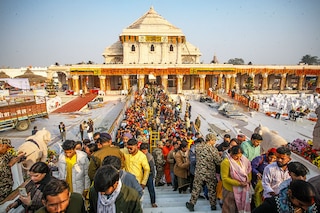When the divine meets dollars: Decoding economics of faith
What explains the connection between the divine and dollars? It is a cultural and economic juggernaut, a collective consciousness that seems to ignite growth


In the heart of Ayodhya, something monumental is brewing. Welcome to the aftermath of the Ram Temple inauguration, a spectacle that"s doing more than just pulling in the devout by the millions it"s turning Ayodhya into a buzzing hub of economic activity. Think of it as the divine meets dollars, a sacred cash cow that"s just started to moo. Uttar Pradesh is expecting ₹4 lakh crore revenue from Ram Mandir Tourism. The Ram Temple is projected to rake in a whopping ₹50,000 crores in revenue, catapulting the city from a mere pilgrimage spot to an economic powerhouse. And the upcoming Ram Land, the Disneyland-inspired theme park, will fuel the economic boom further.
Ayodhya"s transformation of religious fervour into economic prosperity is not an isolated phenomenon. Another set of soon-to-be-inaugurated five major places of worship, including the tallest statue of Hanuman at Hampi and Viraat Ramayan Mandir in Champaran, are also part of a larger narrative of economic growth in the country.
Across time and continents, the intertwining of the sacred and the commercial has driven the development of cities and civilisations. Professor William Bubelis, in his article Temple Economy, Greek and Roman, mentions that ancient sites in Greece and Rome were not just spiritual centres but also pivotal in economic functions, redistributing wealth, and fostering community economic activities. Similarly, other scholars highlight that temple-centered economies were crucial in Northeast Thailand"s Phimai region and acted as the integrative force holding the political and economic systems of the state together. In India, temples alone are estimated to have gold reserves worth $2 trillion, while Europe"s cultural and religious tourism supports 2.6 million jobs, contributing €153 billion to the economy. The global halal market is worth $2.3 trillion, while religion contributes $1.2 trillion to the US economy. The resurgence of Ayodhya, alongside the burgeoning economies of religious sites globally, offers a compelling counter-narrative to the proclamations of Nietzsche and Marx regarding the decline of religion.
Dive deeper into India"s mythological maze, and it"s clear that it is a cultural and economic juggernaut, a collective consciousness that seems to ignite growth. Gods and legends do more than bless they brand. They"re at festivals, on your TV, and in your shopping cart, showing that when culture and commerce collide, it"s not a crash it"s a kaleidoscope of opportunities. Mythology in India isn"t just the stories of gods and demons told during bedtimes they"re the threads weaving the nation"s fabric they are a call to the pilgrimage, a reason to buy, and a way to live. The economic ripple effect? It"s like Marvel on steroids. This explains how places of worship act as artefacts that exteriorise the collective memory and shared values reflecting the society"s cultural narrative.
Also watch: Ayodhya: An ancient city"s new beginnings, in photos
As India leans into the financial windfall of its religious heritage, the big questions loom: How sustainable is this fusion of the divine and dollars? Is it possible to keep this spiritual-economic hybrid engine running without hitting a moral, cultural, or ecological pothole?(Ameya Agrawal is a student of the post-graduate program in business leadership at IIM Kozhikode, and Keyoor Purani is a Professor of Marketing at IIM Kozhikode. Views are Personal.)
First Published: Feb 29, 2024, 14:48
Subscribe Now